The scientific study is dedicated to the 185th birthday of Chokan Valikhanov (1835–1865), the historian, ethnographer, folklorist, traveler, educator, whom all progressive people will honor in 2020. The aim of this article is to study Ch. Valikhanov's large and diverse ethnic and artistic heritage which is of interest to art historians, cultural researchers, and specialists in art education. Portraits, drawings, sketches, as well as schemes and plans of CH. Valikhanov, made in different periods of life, reflect the history and Ethnography of the Kazakhs, Kirghiz, Uighurs and other peoples of Central Asia, reproduce the nature of his native land. To some extent, Chokan Valikhanov lays the foundations for future professional painting – portrait, landscape and household genres. An analysis of the material showed that Ch. Valikhanov's artistic heritage is of great importance as one of the foundations of the realistic direction of Kazakh fine art. In addition, it has the great humanistic potential for moral and aesthetic education and enlightenment.
In the article «Bolashakka Bagdar: Rukhani Jangyru» – «Looking into the Future: Modernization of Public Consciousness» the first President of the Republic of Kazakhstan N.A. Nazarbayev, the Leader of the Nation emphasizes that «even substantially modernized societies contain cultural codes, the origins of which date back to the past... The first condition for a new type of modernization is the preservation of the culture, the preservation of the own national code ... A new modernization should not arrogantly reject historical experience and traditions. On the contrary, the best traditions should become a prerequisite, an important condition for the success of modernization ... This means that history and national traditions should be taken into account. This is a platform that connects the horizons of the past, present, and future of the population» [1].
The national cultural code is preserved in time and space by its translation in certain forms in the national language, literature, art, and social practices. It manifests itself in any of the areas of the social and spiritual life of the people.
In this context, the significance of the personality of Chokan Valikhanov and his unique ethnic and heritage increases. An initial study of this issue is provided in the educational publication «History of Kazakh Art» [2; 98] and in the short opinion piece «Ethnic and artistic heritage of Chokan Valikhanov» [3]. The article by A.Kh. Margulan was of critical importance to the study of Ch. Valikhanov's artistic heritage [5].
Chokan Valikhanov's personality. Ch. Valikhanov and G. Potanin
Chokan Chingisovich Valikhanov (1835–1865), a scientist, an educator, a descendant of the Great Abylay Khan is a phenomenon in the establishment of Kazakh culture. He was a Eurasian by conviction and he led his people towards the way of Russia and other civilized countries by the acquisition of knowledge. His worldview was developed during his studies in the Omsk Cadet Corps, where he studied History of Kazakhstan, Central Asia, and Russia, the works of classics of Russian literature. Chokan Valikhanov continued his education in the 1860s in St. Petersburg.
According to Professor Nikolay Ivanovich Veselovskiy, they expected great and important revelations about the fate of the Turkic peoples from the descendant of the Kazakh khans and sultans and the Russian officer. But Chokan's early death took away these hopes. Not only the scientific and literary heritage of Chokan Valikhanov but also his artistic heritage are very valuable.
The ethnic and artistic heritage of Chokan Valikhanov is large and diverse and is of interest to art historians, cultural researchers, and specialists in art education. The main artworks of Ch, Valikhanov are kept in the archives of the St. Petersburg Institute of Oriental Studies, the Geographical Society and the State Library named after Saltykov-Shchedrin; some of the drawings are kept in the Tomsk archive of G.N. Potanin.
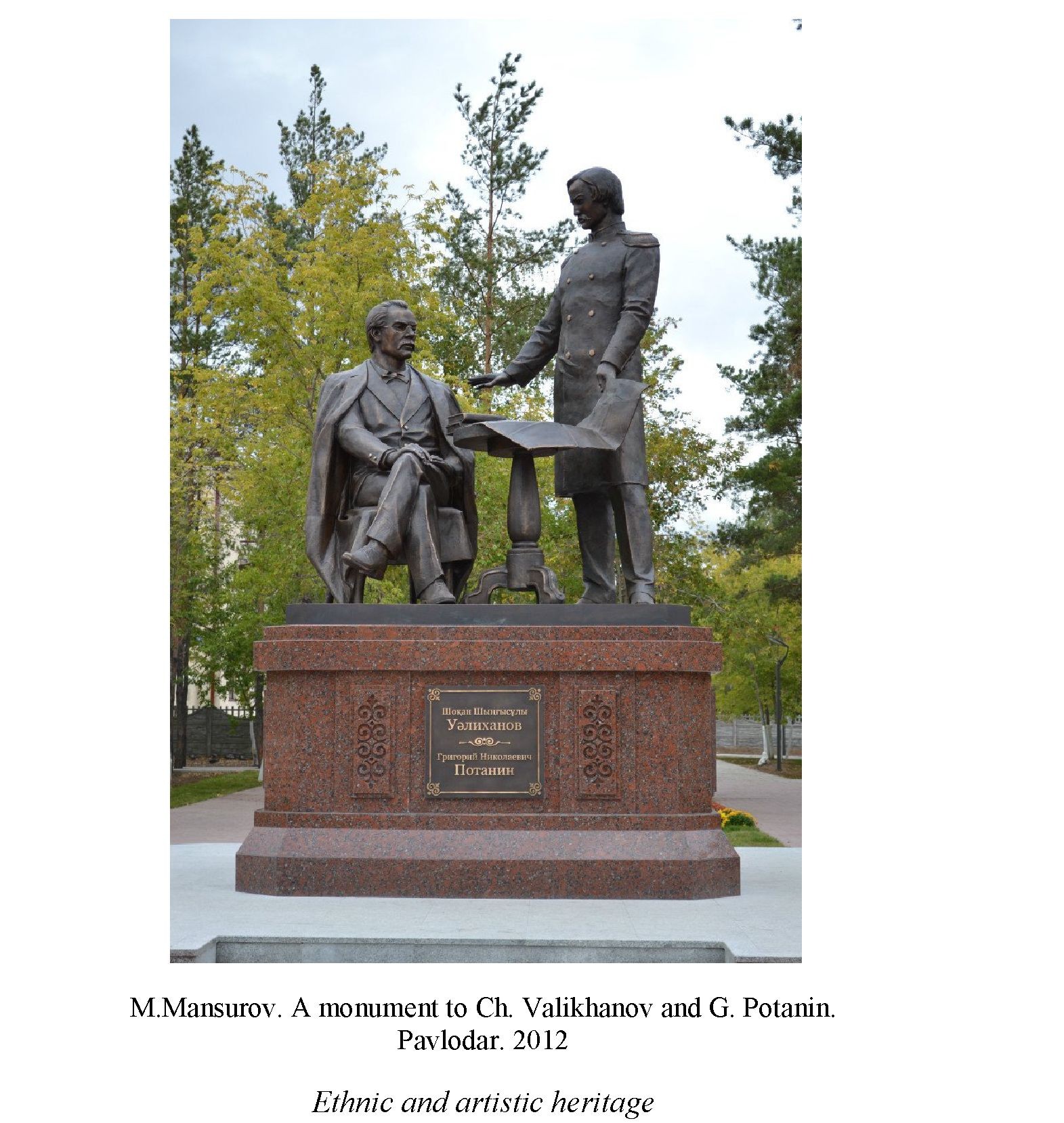
Ch. Valikhanov got acquainted with G. Potanin during his studies in the Omsk Cadet Corps in the 50s of the 19th century, and they remained friends for life. At the beginning of his studies in Omsk, Chokan did not speak the Russian language, and at first, he was helped by Gregory, who later became his faithful companion.
In his memoirs, Potanin noted that when Valikhanov was 14–15 years old, the leadership of the Cadet Corps already predicted that he would become a major researcher and even a scientist in the future. Grigoriy Nikolayevich Potanin graduated from the Cadet Corps in 1852, and he went to work in Semipalatinsk, from where he later went on a campaign. Chokan Valikhanov graduated from the Cadet Corps at the rank of cornet and was assigned to the 6th regiment of the Siberian Cossack Troops.
By fate the friends had different life paths: G. Potanin lived a long life, C. Valikhanov died in the prime of his life, but their creative and spiritual contact was eternal. In 2012, a monument to two world-renowned scientists was erected in Pavlodar. The monument became the embodiment of «friendship for life».
One should outline the main directions of Ch. Valikhanov's ethnic and artistic heritage. Portraits, drawings, sketches, as well as schemes and plans made by Ch. Valikhanov in different periods of his life, reflect the history and ethnography of Kazakhs, Kyrgyz, Uyghurs and other peoples of Central Asia, and also represent the nature of their native land. To a certain extent, Chokan Valikhanov laid the foundation for future professional painting, such as portrait, landscape and genre art. [4].
There were elements of romanticism in the worldview of young Chokan Valikhanov, which manifested themselves in his love for folk tales; he enthusiastically wrote down the stories and songs of the steppe, versions of the poem «Kozy Korpesh and Bayan Sulu». His drawings were simple and realistic.
According to the memoirs of G.N. Potanin, Ch. Valikhanov loved to draw since childhood. Unfortunately, the drawings of young Ch. Valikhanov did not survive to us. He could have acquired some artistic skills in the Kushmurun Kazakh school, organized by his father when Chokan was seven years old, in 1842. The school program included such subjects as history, geography, mathematics, oriental languages.
In 1847 Chokan entered the Omsk Cadet Corps [4; 155]. During the studies in the Cadet Corps, he showed particular diligence in drawing; and with his abilities, he managed to acquire quite thorough knowledge of humanities, natural and applied sciences, architecture, and topographic drawing. In the Cadet Corps, a special course «On the importance of architecture and its constituent elements» was taught. Cadets received the training, took part in topographic expeditions every year and conducted geodetic survey. In 1850 Chokan conducted a field survey of Turgay and Ishim steppes (topographic drawings, drawings, survey images are kept in the archive of the Russian Academy of Sciences).
In the Cadet Corps, topographic drawing and drawing were taught by experienced professionals, such as the artist A. Pomerantsev, the geographer Ye.I. Starkov and the scientist-geodesist Borodin. They carried out interesting research on the history and geography of Kazakhstan in the middle of the 19th century.
The communication of Chokan with the artist A. Pomerantsev, who taught topographic drawing and drawing in the Cadet Corps determined the development of Chokan's graphic abilities. Chocan was interested in both painting and drawing.
Most of Ch. Valikhanov's drawings are made in lead pencil, pen and ink; there are works made in watercolors, oil.
Ch.Valikhanov's drawings can be systematized in line with the time of education:
- child's experiments in Kushmurun (1842–1847);
- watercolor drawings and drawings during the studies in the Omsk Cadet Corps (1847–1853);
- sketches during the first travels in Kazakhstan (1852–1853);
- field sketches during the Issyk-Kul expedition (1856);
- watercolor drawings and drawings during the trip to Gulja (1856);
- portraits and drawings made in Kashgar (1858–1859);
- portraits painted in St. Petersburg (1860–1861);
- portraits of people and ethnographic sketches made in the native village (1862–1865).
Among the early artworks of Ch. Valikhanov, two watercolor drawings «Akshomchi» and «Jatak» attract special attention. In these early watercolor drawings, it is possible to notice the features of the future artist Ch. Valikhanov, such as a close interest in the surrounding everyday details, a desire to create an expressive and lively episode from the life of ordinary people even in a small sketch and at the same time to link the real genre scene with the poetic image of the native nature.
Topographic landscapes, schemes, and maps
Topographic landscapes of his native places, schemes, and maps of Ubagan and Syrymbet districts, and the views of his native estate constitute the majority of watercolor drawings and drawings of young Chokan. The estate of Syrymbet (the estate of Chingis Valikhanov) was the family estate of the Valikhanovs, who were direct descendants of the Kazakh khan Abylay. The estate was located in the territory of the current village of Syrymbet, Ayyrtau district of North Kazakhstan region of Kazakhstan.
Ch. Valikhanov spent his childhood and youth in the estate; he came there on vacation from the Cadet Corps and lived there in 1862–1864. The estate played an important role in the dissemination of educational ideas and culture in the Kazakh steppe. Sergey Durov, a poet from the Petrashevsky Circle, who influenced the development of the opinions of Ch. Valikhanov, came there in the summer of 1856; Grigory Potanin came in the summer of 1895. Aytys of singers and musicians took place in the estate; famous composers Birzhan-sal Kozhagulov and Akhan-sere Koramsin, a kobyz player Kurumbay Kangozhin, a singer Koke Aldzhanov, a poetess Azhar performed there.
Among the graphic works devoted to the topography of Syrymbet, the sketches of the estate of grandmother Ayganym made in the form of plans and perspective drawings are of great historical interest. The general view of the estate with its landscape against Syrymbet Mountain is the most interesting of them. The estate was located at the northern foot of the mountain, in a clearing in the woods. A wooden fence enclosed five wooden structures: a large house of the khan's wife Ayganym, a bathhouse, a spacious storage room, a madrasah, and a mosque.
In the drawing, there are two figures close to the gates: a man and a woman in national clothes. Northeast of the estate, there are other wooden buildings belonging to Chingis, the father of Ch. Valikhanov. Next to them, there is a silhouette of a summer yurt; another larger yurt is not far from the estate. It was typical for the population of Kazakhstan to use settled and nomadic dwellings. In the drawing of Ch. Valikhanov, the yurt is of ancient form. Between the yurts, there is a platform – scaffolds made of boards for having some rest, conversation and listening to the performance of folk akyns.

All the drawings made at this time are collected in one notebook and are called «Sketches made during the holidays in the village».
The pictorial schemes of Kazakh kystau and jailau, where the area of Lake Ubagan, the favorite place of Chokan, is depicted are of great historical interest. He spent his childhood there. It is natural that he devoted a lot of works to depicting his native area. Ch. Valikhanov's cartographic works are original works of art executed with professional skills and elegant graphic design.
A drawing of the estate of Syrymbet made by Chokan in the same year of 1852 can be considered as an example of a topographic landscape.
The data of Chokan Valikhanov's maps related to the topography of Syrymbet are of exceptional importance to study Valikhanov's biography. Syrymbet was a favorite place of residence for Ch. Valikhanov. When he was tired of working in the city or he was ill, he always returned to his native places to rest and improve his health and to acquire new strength. Therefore, it is understandable why he addressed to Syrymbet in his work more than once (the topographic map of Syrymbet No. 1). The topographic map of Syrymbet No. 2 is particularly interesting. Besides the points known from the first map, the grave of the khan's wife Ayganym is marked on the map. Apparently, this map was made shortly after the death of his grandmother. It is important to note that each map made by Ch. Valikhanov is not only of geographical significance but also of historical and cultural significance.
The layout schemes of winter and summer sites of the auls of Aman-Karagay and Kokchetav districts, postal pickets, general maps of Turgay and Ishim steppes and others also refer to topography. Watercolor drawings and schemes may have been made by Chokan as practical exercises in the field. He could have performed this work during the holidays when he came to the aul for summer.
In 1856 Ch. Valikhanov conducted the first scientific research on the life of the Kazakhs of the Great Horde and the Kyrgyz. This research expanded not only the scientific range but also the thematic range of his artistic work. Sketches of Ch. Valikhanov are distinguished by strict documentary and are closely related to his studies on ethnography and folklore, ancient beliefs; they clearly illustrate his research. This is how landscape and genre art became close in Ch. Valikhanov's art.
His watercolor drawings depicting the peaks and glaciers of Kungey and Terskey, reliefs of the Dzungarian and Ile Alatau, Khan Tengri syrts, panoramic views of the Ili River with the views of the surrounding Alatau, Buguty, Toraygyr mountains are distinguished by true monumentality.
Portraits
The portrait painting features prominently in the heritage of Ch. Valikhanov, for example, portraits of historical persons and ordinary people depicting the type of people of Central Asia and Kazakhstan: «Buranbay», «Sartay bi», «Mamyrkhan», «Senior Tezek Sultan»; «A Kyrgyz in a colorful robe»; portraits of the relatives and friends: «Portrait of Chokan's Uncle Kangozha»; a group portrait of brothers, friends and companions on expeditions. Among the portraits, the portrait of Tezek Sultan stands out. The sultan is painted in a half-sitting position with hands folded; his proud face with an aquiline nose and sharp eyes are well- depicted. He is dressed in an old caftan; there is a large round hat on his head which is decorated with a feather of a heron. He is a famous sultan of the Senior Zhuz, who had a poetic talent and more than once performed in competitions with prominent akyns of Semirechye.
One of the remarkable works of Ch. Valikhanov is the portrait of a Kyrgyz man, executed in watercolor. The appearance of the Kyrgyz man is expressive; he has a round head, wide forehead, black eyebrows, slightly protruding ears, and a small flat nose. The Kyrgyz man is in a humble kneeling position. There is a skullcap of a conical shape on his head; he is dressed in a colorful robe, typical for the southern Kyrgyz. The texture of the silk robe is masterfully conveyed. You can see a wide cloth belt under the edges of the robe with which is used to wrap the waist. Painting portraits of the Alatau Kyrgyz from Alatau region, Ch. Valikhanov accurately captured the ethnic type of the Kyrgyz, their character, everyday life details, and ethnographic features.
The sultan of the Senior Zhuz Mamyrkhan Rustemov is also depicted with great skill. The dry face of the sultan, his cold eyes, arrogance, frozen posture are clearly conveyed.
The portrait of Sultan Buranbay is depicted with a stingy but expressive touch; Ch.Valikhanov shaded his penetrating eyes, straight nose, curly whiskers, and mustache.
Creating a series of individual and group portraits, Ch. Valikhanov could not but depicted his relatives. A group portrait of the brothers executed in a quite restrained manner, but with a great sincere feeling, and is full of psychologism. Three boys huddled together; they are Chokan's younger brothers, painted during the migration of the Valikhanovs' aul. The background for the drawing is the wall of a yurt, hastily installed during the caravan's halt. Along the wall of the yurt, there are thick felts; the boys are sitting near them. Household items are scattered nearby: some bowls, a saucer, a tobacco grater, and others. In the drawing, Chokan conveys the atmosphere which was typical during migrations. Boys have different characters and psychological traits. It is known that several younger brothers of Chokan died when they were young. There is a sad, young man sitting on the left; he looks sick; he is rolled in a loose robe. In the center, there is a boy with delicate facial features that convey the appearance of Sakhib-Kerey or Kozyke. The face is dreamy, but at the same time it has a worried look. Subsequently, Kozyke became a famous poet and musician; he was the author of several wonderful Kazakh songs. On the right, there is a strong young man calmly looking forward; apparently, this is Makhmud. According to contemporaries, among all the children of Chingis Valikhanov, Zhakup and Makhmud were the most physically strong. Despite the difference in the characters of the boys, the artist unites them with the common sentiment, in which there are some anxiety and concern. This drawing is one of the examples of how Ch. Valikhanov, being stingy with the means and the strokes, was able to convey the inner world of a man.
In the other portrait, Ch. Valikhanov portrayed his uncle, the famous musician Kangozha, to whom he was extremely attached from an early age. He was one of the creators and virtuoso performers of Kazakh kyui; unfortunately, sheet music of the kyui was not written down. Kangozha is depicted full face, wearing a dark robe, wide open at the front. Under the robe you can see a checkered camisole and a white shirt with a
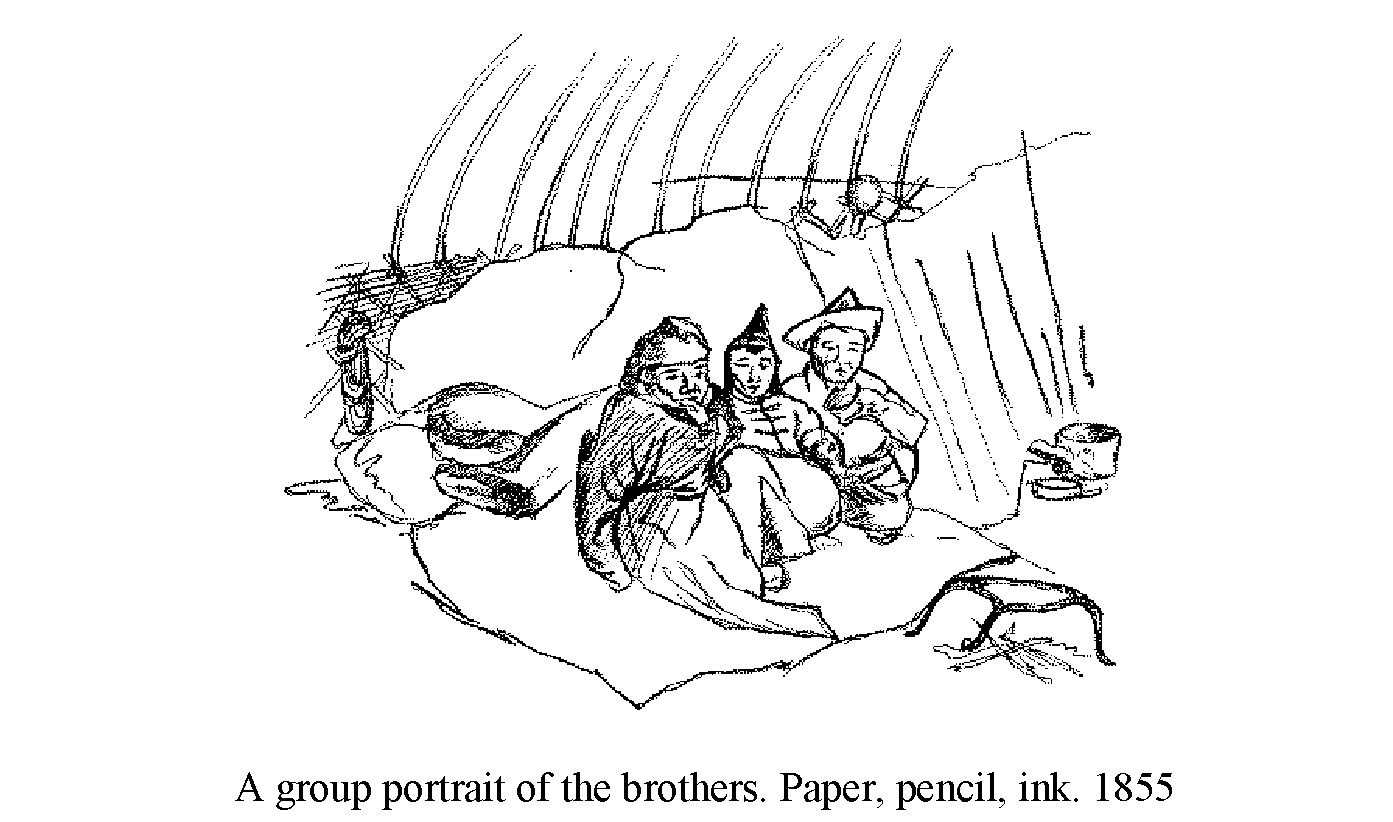
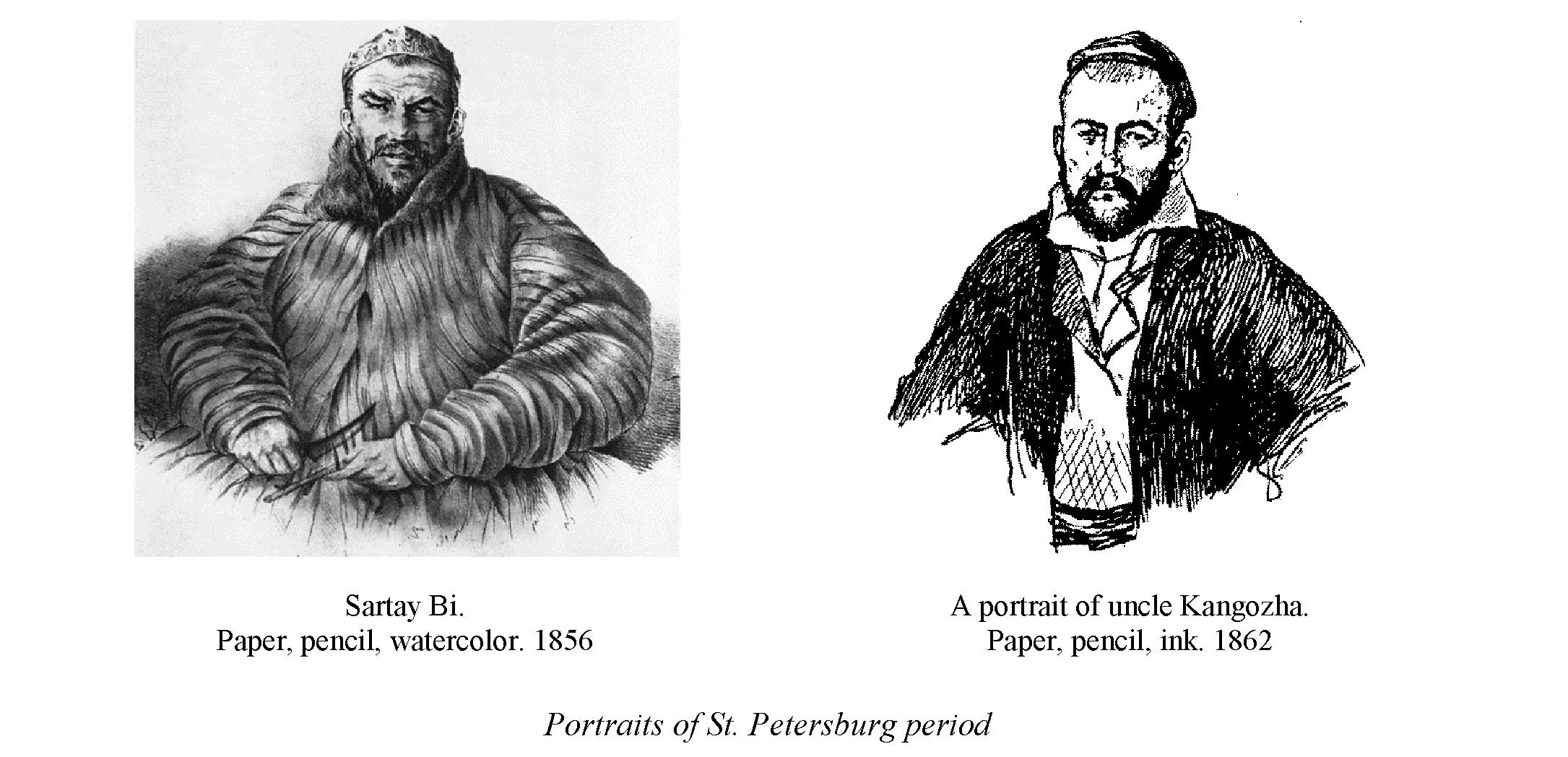
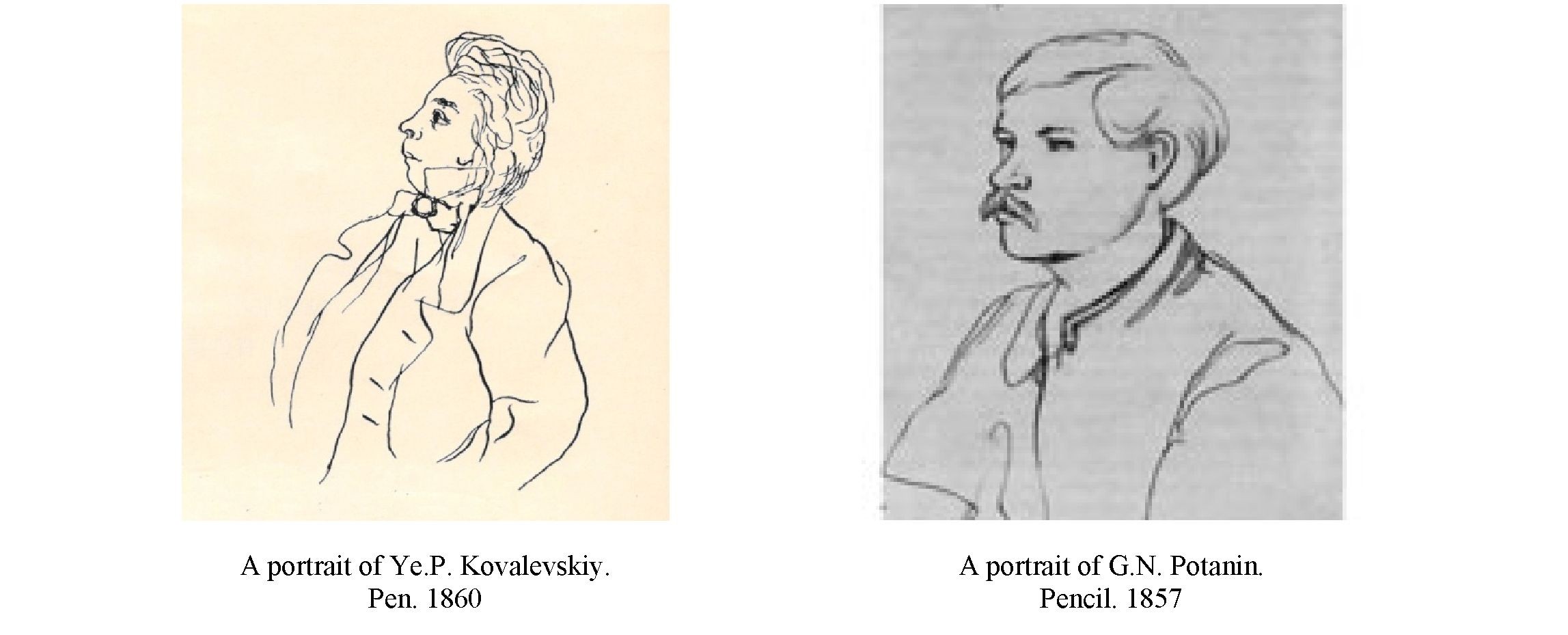
43
wide turn-down collar, typical for elderly Kazakhs, as well as for folk singers and musicians. The soft features of Kangozha's face, his wide forehead, thoughtful eyes, and whiskers are expressively depicted in the portrait. At the same time, Chokan depicted not only the external appearance of his uncle but also his inner world, restraint, and calm character. Thanks to this portrait, Ch. Valikhanov preserved for posterity the memory of a man who played a great role in the history of the musical art of the Kazakh people.
Ch. Valikhanov portrayed his close friends and companions on expeditions many times. In 1857 after a long separation, with great skill and in a soft manner, he portrayed his big friend G.N. Potanin, depicting the appearance of the famous scientist in a certain manner – his smart eyes, wavy hair, «Potanin's» mustache.
In St. Petersburg, Chokan sketched out a portrait of Yegor Petrovich Kovalevskiy, a famous traveler, diplomat, orientalist, Honorary Member of the St. Petersburg Academy of Sciences.
A number of sketches are devoted to depicting the type of the Kazakhs of the Senior Zhuz.
The original pencil sketch «The Kazakhs of the Great Horde» attracts attention. It may be a sketch of a monumental canvas planned by the author. Fifteen figures of the Kazakhs are presented in one composition – this is a multi-figure composition where individual characters with individual psychological traits are depicted in a confident manner.
The travel sketches made by Valikhanov on the route from Ayaguz to Lake Issyk-Kul, when he participated in the Issyk-Kul expedition in 1856, are of great historical and cultural value. Among them, there are quite a lot of panoramic, landscape and genre sketches.
There are a lot of sketches of eastern women, such as «Kyrgyz women of the Issyk-Kul area», «A woman from Kashgar», «Kazakh women near the yurt». They are drawn from real life, and they accurately convey the characteristic features of the appearance of Kyrgyz women. By fixing the details of everyday life, clothes, the way of life of people, Ch. Valikhanov achieves expressive authenticity in his drawings.
A significant series of genre and landscape sketches were made by Chokan Valikhanov during his trip to Gulja (1856). This series includes sketches made with a pen, such as «Hunting in the Dzungarian Alatau» and «A Camp near the Ili River in Western China». In the last sketch, Ch.Valikhanov depicted the halt of the team on the upper Ili bank, in the area of Khorgos. Inside the camp, there is a camel and a horse kept on a leash. Near the horse, there are two men sitting under a tree, the third man is in a kneeling position – a sign of courtesy when meeting with strangers.
Among the series of Gulja sketches, a sketch, depicting the official meeting of Ch. Valikhanov and his companions (I. Zakharov and M. Peremyshlskiy) with local Chinese dignitaries is of a significant historical and artistic interest.
The sketch was made based on psychological observation of the character and manners of Chinese dignitaries. Drawing their portraits, Valikhanov simultaneously describes their appearance and inner world. Valikhanov wrote about this meeting in his diary: «Tugolday is a thin old man with weak narrow eyes, wearing huge glasses, with a hawk nose ... He is active beyond his years and is extremely talkative, dressed in a silk robe, girded with a black belt, on which a bag with tobacco and a fan are hanging» [5; 18]. Ch. Valikhanov accurately depicted the appearance of Tugolday described in the diary. Tugolday is sitting in a chair at the end of a long table, and, exchanging words, makes a meaningful and mannered hand gesture. Kogoldai, a man with a weighty body, a flat face, a short neck, and a peculiar bearing is depicted accurately. There are also other Chinese officials, as well as Russian representatives – Ch. Valikhanov himself, next to Kogolday; M. Peremyshlskiy on the left side of Valikhanov, and I. Zakharov, who is passing the letter to Tugolday.
The drawing is not only an accurate illustration of the history of Russian-Chinese diplomatic relations but also an example of the graphic art of Ch. Valikhanov.
Music in drawings
Two drawings made by Ch. Valikhanov «Baksy» and «Kazakh musicians» are of particular value to the history of the spiritual culture of the Kazakhs. There is an ancient poet playing kobyz in the drawing «Baksy». The drawing «Kazakh musicians» is a bit mysterious. Judging by the accompanying inscriptions in the Kazakh language, it is of significant interest to researchers of the history of Kazakh music. There are six Kazakh musicians who lived in the middle of the 19th century depicted in the drawing; among them, there

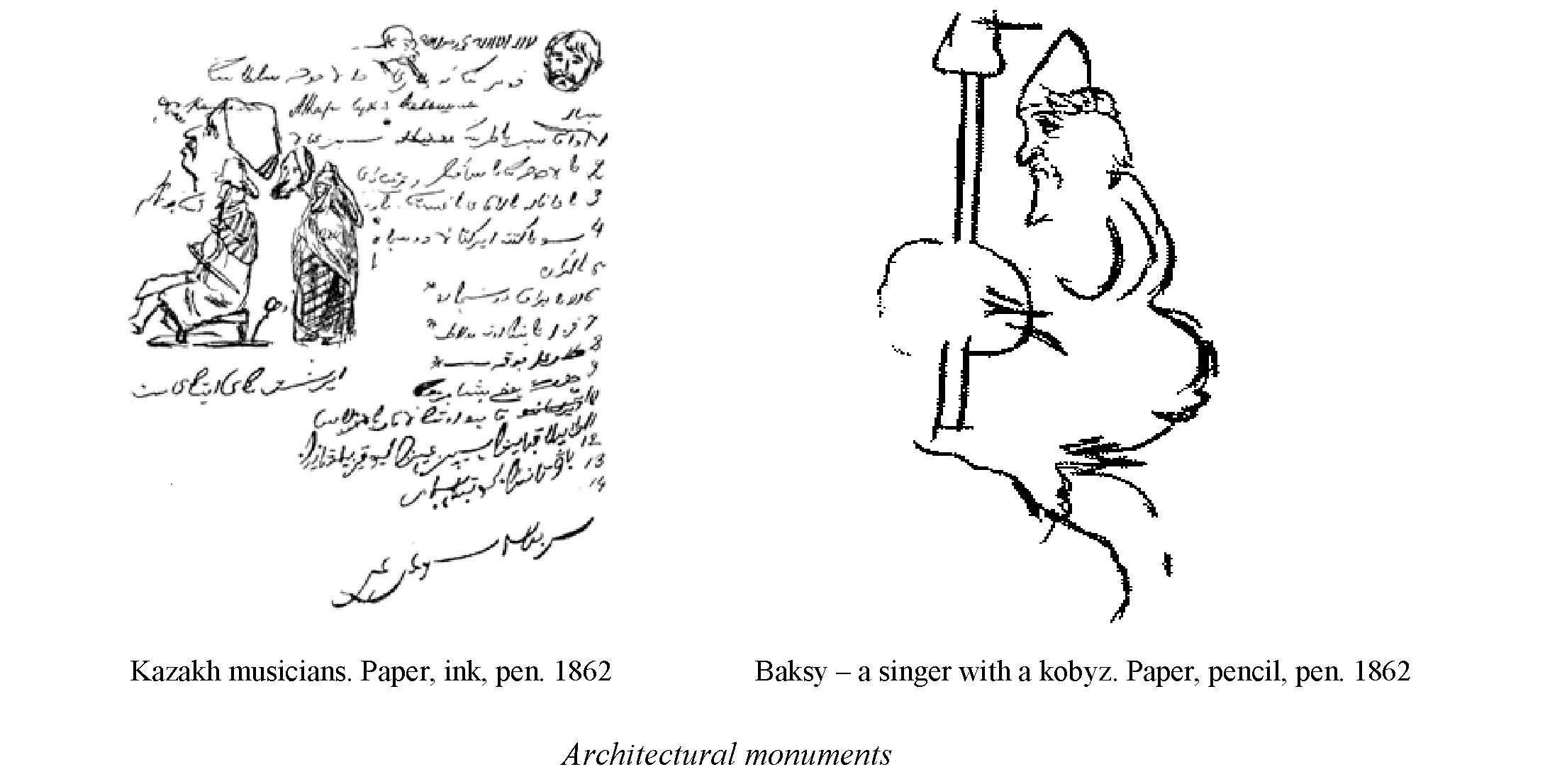
45
are Kangozha Valikhanov – a famous kobyz player who played a lot of kyuis to Chokan; an old singer, a celebrated musician Doszhan; a famous singer Zhanak; an unknown musician; a young woman who may have been the Kazakh poetess Azhar-akyn. There are several Kazakh kyuis, which these musicians must have performed.
This characterizes Valikhanov's observation, the features of his manner of drawing, which are swiftness, plasticity, laconic expressive means.
Many drawings depicting various architectural monuments have been preserved: the mausoleums of Zhuban-Ana and Aytbulat on the Sarysu River, of Butagay on the Nura River (the 13th – 14th centuries) and many others. The oldest of the mausoleums is Zhuban-Ana. This is a building with a dome in the center, made of burnt brick, built according to the corbel arch system – an architectural technique typical for the Kipchak architecture of the pre-Islamic period (the 8th – 10th centuries). Aytbulat mausoleum was built with a more complex construction technique; it is erected on spandrels. Ch. Valikhanov captured not only the general view of this monumental structure but also sketched its interior. Apparently, Valikhanov was impressed by the beauty and monumentality of this mausoleum.
Chokan Valikhanov showed particular interest in studying the monuments of his native country. Among these sketches, the reproduction of the sculptural composition «Kozy Korpesh and Bayan Sulu» is of great historical and cultural value; the sculptural composition located near an ancient architectural monument, known under the same name on the Ayaguz River. Chokan Valikhanov wrote: «I really love and admire the Ayaguz River, the possible reason for it may be the poetic legend about the love of the beautiful Bayan for the golden-haired Kozy Korpesh, which took place on this river ... We have studied the poem well and therefore we would certainly like to see their grave» [5; 22]. For this purpose, on the night of May 10, 1856, he made a long and tiring trip from the Ayaguz to Tansyk. He examined the monument after returning from the expedition to Issyk-Kul and to Gulja. He passed by the monument when he made his trips to the Alatau Kyrgyz (1857) and to Kashgar (1858 – 1859). During one of such trips, he may have drawn of the sculptural composition «Kozy Korpesh and Bayan Sulu». This drawing is made with pen and ink; it depicts sculptural images of three women and one man. According to the folk legend, one female statue depicts Bayan Sulu, the second one – her sister Aygyz, the third one – her aunt, a male statue depicts Kozy Korpesh. All the statues are holding sacred vessels in their hands; there are wedding headdresses (saukele) of a conical shape on the heads of two girls-brides, the third woman has a headdress of a young Kazakh woman (kimeshek), which still exists today. The head of a man's statue was beaten off, and Valikhanov had to draw the statue like it was.
Today, this sculptural composition is no longer there, so it is possible to learn about it only from the sketches of Ch. Valikhanov and an old photograph made by Ye. Baranov.
Серия «Педагогика». № 1(97)/2020
Rock carvings
Ch. Valikhanov showed considerable interest in rock carvings, which are often found in the mountains of Kazakhstan. The sketches of the painting known as Tamgalytas (Stone Writing) deserve special attention: «Images of three Buddhas on the rocks of Tamgalytas»: in the center, there is the many-faced and many-armed Buddha Chon-Rai-Chik (Zhang-Rai-Sik); on the left, there is Shakl-Muni; on the right, there is Tan La. This monument was made by real masters who knew Buddhist art well; the painting was done using high and delicate stone carving techniques; it is distinguished by the clarity of drawing and the plasticity of contour lines. All scientific data (D.A. Pozdneyev, G.F. Miller) indicate that Buddha images and Tibetan prayer inscriptions were made by the Dzungars during their rule in Dzungaria and East Turkestan.
Besides studying the monuments of ancient art, Ch. Valikhanov was also interested in samples of ancient writing, signs of family and patrimonial property (tamg), and coins. He studied the traditional astronomical representations of the Kazakhs, in particular, the Kazakh folk calendar. The result of this work was the sketch «Starry Sky» – an astronomical picture of the starry sky.
Summarizing the study of the ethnic and artistic heritage of Chokan Valikhanov, one should conclude that as an educated person of his time, a scientist and educator, he clearly understood the general purpose of art. It seems to us that he realized the important task of a realistic depiction of people's life in its various aspects.
At the same time, it is important to stipulate that the study of the artistic heritage of Ch. Valikhanov proves the different character and quality of his works. The analysis showed that among them there are professional works and amateur drawings. Most sketches made casually during the expeditions in which he participated are amateur.
This difference was possibly due to his attitude to his art, which he considered complementary to his main scientific activity.
Nevertheless, the ethnic and artistic heritage of Ch. Valikhanov is of great importance as one of the foundations of the realistic direction of Kazakh fine art.
Academician A. Margulan rightly notes that «the study of Valikhanov's great artistic heritage is the noblest task of our modern art history, because it is a basis for a study of the fine art of Kazakhstan» [5; 28].
References
- Nazarbayev, N.A. «Bolashakka Bahdar: Rukhani Zhanhyru» / Vzhliad v budushchee: modernizatsiia obshchestvennoho soznaniia [«Looking into the Future: Modernization of Public Consciousness»]. akorda.kz. Retrieved from http://www.akorda.kz/ru/events/akorda_news/press_conferences/statya-glavy-gosudarstva-vzglyad-v-budushchee-modernizaciya- obshchestvennogo-soznaniya [in Kazakh].
- Zolotareva, L.R. (2000). Istoriia iskusstv Kazakhstana [History of Kazakh Art]. Karaganda: Izdatelstvo KarHU [in Russian].
- Etnokhudozhestvennoe nasledie Chokana Valikhanova (2012) [The ethnic and artistic heritage of Chokan Valikhanov]. Proceedings from Philology, Art History and Cultural Studies: Past, Present, Future: mezhdunarodnaia nauchnaia-prakticheskaia konferentsiia — International Scientific Conference. (Part 2; pp. 28–32). Novosibirsk: Izdatelstvo «SibAK» [in Russian].
- Beysenbayuly, Zh. (2016). Chokan Valikhanov. Istoriko-biohraficheskoe povestvovanie [Chokan Valikhanov. Historical and biographical narrative]. Astana: Foliant [in Russian].
- Margulan, A.Kh. (1982). O khudozhestvennom nasledii Chokana Valikhanova [About the artistic heritage of Chokan Valikhanov]. Ch.Ch. Valikhanov. Collected works. (Vol. 1-5; Vol. 5). Alma-Ata: Hlavnaia redaktsiia Кazakhskoi sovetskoi entsiklopedii [in Russian].